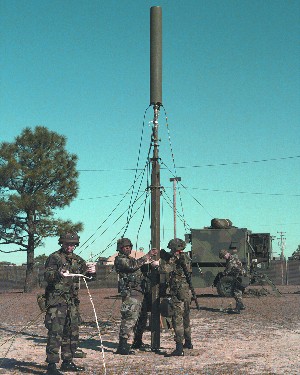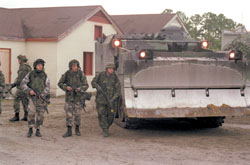Smart Radios Juggle Spectrum
 |
When U.S. forces operate overseas, they must first determine that their radio frequencies do not interfere with local and coalition communications. The manual process of assigning frequencies to all the radios involved in a mission is complex and time-consuming. One goal of the U.S. Defense Advanced Research Projects Agency's (DARPA's) Next Generation Communications (XG) program is to develop intelligent radios that have all national frequency spectrum protocols stored in memory. |
An advanced wireless communications system soon will allow military and civilian users to access spectrum more efficiently than does current equipment. Radios using this spectrum allocation technology will sense their local electromagnetic environment and transmit messages through available areas of spectrum. Designed for global use, these intelligent devices will store nations’ spectrum protocols on microchips for automatic, seamless operation without the need for lengthy frequency allocation negotiations.
As available radio spectrum becomes scarce from increased commercial and government communications use, the ability to allocate the available spectrum efficiently becomes paramount. Dynamic spectrum allocation is vital for commercial users in oversubscribed urban areas and for military forces that must match frequencies with coalition allies. But frequency assignment has been a manual chore for more than a half century. By applying advanced processing and software technologies, researchers are laying the foundation for a family of radios that can manage frequencies without human intervention.
The goal of the Defense Advanced Research Projects Agency’s (DARPA’s) Next Generation Communications (XG) program is to develop radio systems that actively sense the electromagnetic environment and use free, unassigned portions of spectrum for message transmission. This dynamic spectrum management, technology will permit communications equipment to operate anywhere in the world without spectrum availability conflicts.
According to Preston F. Marshall, program manager at DARPA’s Advanced Technology Office, Arlington, Virginia, the XG program evolved from efforts to measure and develop opportunistic spectrum technologies. The need for dynamic spectrum management is critical, but the technology does not yet exist, he says. Today, frequencies must be manually loaded into or assigned for radios. Military spectrum managers have an especially difficult job. Marshall notes that when U.S. and coalition forces entered Iraq, all of their communications systems had to be assigned specific frequency bands to avoid conflicts. “Essentially, the technology from World War II onward has remained relatively static. We’ve automated the accounting, but it’s still basically a human process of thinking about how to deconflict,” he explains.
Software-defined radios are an important step toward full XG capability, but current equipment cannot sense the environment. Another step is to make software-defined systems as efficient and reliable as hard-wired radios, he says. XG is being built based on the assumption that technologies such as the Joint Tactical Radio System (JTRS) will succeed. As the technology is mastered, Marshall notes that DARPA engineers plan to transition and integrate XG into programs such as JTRS. Another important component of XG is the wideband networking waveform being developed for JTRS because, while the U.S. military has a tactical wireless Internet, it is not as ubiquitous or high-speed as landline connections.
One recent development that may transition into XG is the U.S. Army’s Soldier Level Integrated Communications Environment (SLICE). This technology evolved from DARPA’s Small Unit Operations Situation Assessment System program to provide tactical situational awareness for individual soldiers (SIGNAL, June 2001, page 21). First-generation SLICE technology is being integrated into JTRS and other programs. “We have demonstrated that you can build truly mobile ad hoc Internets. You can manage them, and they are quite capable in terms of performance,” he says.
Even if a new generation of radios can automatically use free spectrum, there may not be enough available. Another part of the XG involves creating a policy framework to permit the dynamic use of available spectrum anywhere. During the Cold War, spectrum access was coordinated between the United States and its allies, Marshall observes. But as U.S. forces deploy across the world to fight terrorism and regional instability, he explains, there is no time for pre-planning or international coordination.
The other half of DARPA’s vision calls for flexible communications systems that permit U.S. forces to deploy overseas and work within different national frameworks without having to plan thousands of frequency assignments for each radio. Although XG radios will be capable of accessing spectrum at 10 times the speed of current equipment, intelligently managing that spectrum is a critical part of the process. “Warfighting is very dependent on coalition allies. We went into Iraq, but we had to work with Kuwait. In operating in Iraq, we wouldn’t want to take out Kuwait’s cell phone and television systems. If we’re not going to be good neighbors, people aren’t going to cooperate with us,” he says.
Work on the project is occurring in stages. The first phase of the XG program allowed DARPA scientists to understand the need for dynamically reassigned radios to sense the environment and learn from it. DARPA researchers also discovered that for the radios to operate globally, these devices would have to roam across national communications systems. To do this, a policy was developed in conjunction with the spectrum reassignment technology. “It’s not enough to implement the XG function. We’ve also got to be able to adapt it to each country that we might go into,” Marshall offers.
If the program achieves these goals, it will help the U.S. Defense Department by eliminating the need to generate frequency management paperwork or to conduct lengthy, time-consuming negotiations to deconflict radio spectrum. If the world’s nations accepted a set of principles recording their frequency requirements, then all of these rules could be stored electronically in a radio’s memory. As a radio is moved, it automatically will implement the principles of the country in which it is operating, he says.
Phase 2 of the XG program concentrates on designing the prototype system. Three competing industry teams are developing solutions for DARPA. This work is mostly with software and algorithms instead of physical systems, Marshall explains. The competing teams will design their solutions and measure their effectiveness against the agency’s requirements. In June 2004, the team with the most effective design will be awarded a contract to implement and test the technology.
 |
Urban operations can be problematic for military communications. Forces such as these U.S. Marines conducting an urban combat exercise often lose contact with other units because of signals reflecting off of buildings. Future radios based on DARPA's XG technology will benefit from these urban micro-environments by reusing the spectrum in the deflected transmissions. |
The focus on legacy communications also permits XG designers to adapt the system to the final version of the wideband networking waveform being developed for JTRS. The adaptability interests the commercial world because it enables civilian users to apply standards such as 802.11b, 802.11a and Global System for Mobile Communications. By adopting a flexible approach to waveform development, XG systems will include future algorithms optimized for their use. Once legacy waveforms have been adopted and modified for XG, the path will be clear for more specialized algorithms, Marshall says.
DARPA also is coordinating system design for both military and commercial users. The agency is looking to industry to help it develop low-cost production methods and adopt the standard. “It’s advantageous for the Defense Department and business to adopt it because other nations will start to see the benefits of creating machine executable spectrum policies that we can then embrace and use,” he shares.
Several challenges remain, however. The first is to develop technologies that can effectively sense the local electromagnetic environment. Marshall notes that the U.S. military has built many relatively expensive electronic warfare capabilities that can perform this type of spectrum and frequency analysis. The challenge is to implant these into mobile devices but with the low costs associated with commercial consumer electronics.
The second consideration is characterizing waveforms. “A lot of our research has demonstrated that just looking for open and closed spectrum is not enough. You’ve got to understand the signals that are there, how they coexist and what’s a tolerable signal level that does not cause interference. What is the signal level that’s exploitable by the user of that signal?” Marshall explains. He adds that the Defense Department’s work with sophisticated electronic warfare and support measures is helpful in identifying different waveforms.
Reacting and adapting to the environment represent additional operational challenges for XG. Reaction consists of knowing what is in the environment to avoid interference from or interfering with other frequencies. But adapting to changes poses difficulties. Marshall observes that the spectrum environment can be totally different every 10 milliseconds. “We don’t want our network to thrash itself to death by always changing,” he says. To avoid this, the system must be able to transition smoothly between frequency regions and predict future contingencies.
Another challenge is to develop the algorithms to manage ad hoc networks and maintain spectrum. Several industry teams are working on this. Marshall notes that not every effort has to succeed to increase the general knowledge of the subject. “As long as one of them works, we’re doing well,” he shares.
For example, one approach may call for two radios to coordinate with each other automatically, while more ambitious efforts seek to organize dozens or hundreds of radios into a network. “It’s a more desirable solution, but it is a higher risk,” he says of the latter. However, he is certain that at least the simple, two-radio model is achievable, which will be effective in allowing the integration of higher level functions.
Research indicates that the performance of XG communications is actually enhanced in urban and mountainous areas—two zones that traditionally cause trouble with conventional communications. Urban canyons create micro-environments that permit the reflection and reuse of spectrum in a manner that would be impossible in open terrain. Another primarily urban communications issue addressed by XG is the problem of hidden nodes, in which one user can hear and receive messages from another system but cannot transmit back to that radio.
DARPA researchers discovered that some issues, such as propagation and hidden nodes, can be easily solved through XG systems. Aside from creating spectrum management policy, scientists learned much about making the engineering tools and mechanisms to support what is essentially an arbitrary policy. “We’re building an engineering solution that the policy makers haven’t decided what they want to do with,” he offers.
Marshall adds that normally it is the engineering that follows the policy, but through XG, DARPA is providing U.S. and international spectrum management bodies with the means to make any type of regulations they wish. The ability to tailor regulations for communications technologies will help manage the future’s massive wireless data networks, he says.
The technology is leading toward very intelligent radio systems, Marshall speculates. As reasoning technologies become more accessible and microchips become more powerful, this trend will accelerate. DARPA is leveraging its knowledge base on reasoning engines and semantic Web technology (SIGNAL, June, page 59) to work on ontology frameworks. He believes that these techniques are mature enough to begin to merge into radio and network systems.
Other research is focusing on machine learning systems, but the development community has not yet reached a consensus on what lessons to apply to radios. Beyond completing XG, the real goal is to advance the general technology of putting more intelligence in radios, Marshall says. “Spectrum management is an application of that, but it’s only one aspect of the more general problem of making radios and networks become more cognizant,” he concludes.
Additional information on DARPA’s Next Generation Communications program is available on the World Wide Web at http://www.darpa.mil.




Comments